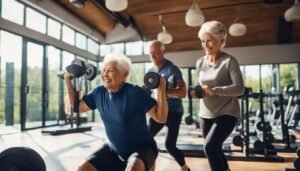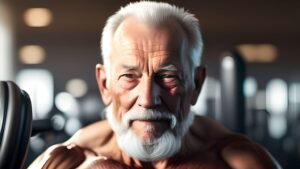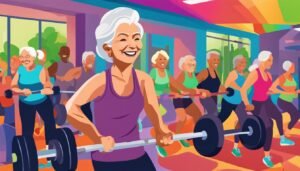Regular exercise is the key to healthy aging. Incorporating fitness routines into our daily lives can help us maintain our health and vitality as we age. Clay Harbor, a fitness expert, suggests six tips for aging gracefully, including strength training, cardio exercise, a proper diet, creatine supplementation, sauna sessions, and deliberate cold exposure. These routines can help build strength, improve cardiovascular fitness, nourish the body, unlock the fountain of youth, detoxify the body, and embrace a vibrant spirit. Dr. Peter Attia emphasizes the importance of incorporating both strength training and cardio exercises into our weekly routines, with 50% reduction in all-cause mortality achievable with just three hours of exercise per week.
Key Takeaways:
- Fitness routines are essential for a healthy aging process.
- Incorporate strength training, cardio exercise, and a proper diet into your routine.
- Consider adding creatine supplementation, sauna sessions, and deliberate cold exposure for optimal results.
- Both strength training and cardio exercises are crucial for longevity.
- Commit to at least three hours of exercise per week for a 50% reduction in all-cause mortality.
The Power of Exercise for Longevity and Wellness
Exercise plays a significant role in promoting longevity and overall wellness. It is not just about adding years to our lives but also ensuring a high quality of life. The World Health Organization advocates for healthy aging, which involves maintaining physical activity, cognitive sharpness, and social engagement throughout our lives.
Research has shown that even small amounts of exercise can significantly extend life expectancy. For example, as little as 75 minutes of brisk walking per week can add almost two years to our lifespan. Exercise also offers a multitude of benefits, including improving physical fitness, cardiovascular health, weight management, mental health, cognitive function, and social connections.
“Exercise is the key to a healthy aging process. By incorporating fitness routines into our daily lives, we can unlock vitality and improve our overall well-being.”
Incorporating exercise into our daily routines can have a profound impact on our well-being as we age. It is never too late to start an exercise routine, and even small amounts of exercise can have a significant impact on our longevity and quality of life. Embrace the power of exercise and age gracefully with a commitment to fitness.
| Benefits of Exercise for Aging Gracefully |
|---|
| Improved physical fitness |
| Enhanced cardiovascular health |
| Effective weight management |
| Positive impact on mental health |
| Preservation of cognitive function |
| Social connections and community engagement |
Elements of a Comprehensive Fitness Routine
When it comes to healthy aging exercises, a comprehensive fitness routine is essential. Such a routine should incorporate a mix of strength training, cardiovascular exercise, and flexibility exercises. Each component plays a crucial role in maintaining our overall health and well-being as we age.
Strength training: This form of exercise helps build muscle strength and resilience, which is important for maintaining mobility and preventing age-related muscle loss. It can be done using weights, resistance bands, or even bodyweight exercises.
Cardiovascular exercise: Also known as aerobic exercise, this type of activity is beneficial for heart health and endurance. It includes activities such as brisk walking, swimming, cycling, or dancing. Regular cardiovascular exercise improves circulation, lowers blood pressure, and reduces the risk of chronic diseases.
Flexibility exercises: These exercises focus on improving flexibility, balance, and range of motion. Stretching, yoga, and Pilates are excellent options for promoting flexibility and maintaining joint health. These exercises also help reduce the risk of falls and promote overall body balance.
It is important to prioritize consistency in your fitness routine. Aim for at least 150 minutes of moderate-intensity activity or 75 minutes of vigorous activity per week. Starting small and gradually increasing the intensity and duration of exercise can help ensure long-term adherence. Remember, it’s always a good idea to consult with a healthcare provider before starting a new exercise routine, especially if you have any underlying health conditions.
| Component | Benefits |
|---|---|
| Strength training | Builds muscle strength and resilience, prevents age-related muscle loss |
| Cardiovascular exercise | Improves heart health, boosts endurance, lowers blood pressure |
| Flexibility exercises | Promotes flexibility, balance, and joint health, reduces the risk of falls |
Remember, it’s never too late to start exercising and reap the benefits of a comprehensive fitness routine. Making exercise a regular part of your daily life can help you maintain a high level of fitness and well-being as you age.
The Impact of Exercise on Physical Fitness and Cardiovascular Health
Exercise has a significant impact on physical fitness and cardiovascular health. Regular physical activity improves strength, endurance, flexibility, and balance, which are essential components of our daily lives. It also helps lower the risk of heart disease, the leading cause of death worldwide, by keeping the heart strong and efficient. Exercise regulates blood pressure and cholesterol levels, crucial metrics for cardiovascular wellness. By incorporating exercise into our routines, we can enhance our physical capabilities and reduce the risk of cardiovascular diseases.
In terms of physical fitness, exercise plays a crucial role in improving overall strength and stamina. Strength training exercises, such as lifting weights or using resistance bands, help build and maintain muscle mass, which is important for stability and mobility. Aerobic exercises, such as brisk walking or cycling, improve cardiovascular fitness by increasing heart rate and lung capacity. Flexibility exercises, like stretching or yoga, promote better joint mobility and reduce the risk of injuries. By engaging in a variety of exercises that target different aspects of physical fitness, we can improve our overall health and well-being as we age.
To further illustrate the impact of exercise on cardiovascular health, let’s take a look at the following table:
| Exercise Type | Benefit |
|---|---|
| Aerobic exercises (e.g., running, swimming) |
|
| Strength training exercises (e.g., weightlifting, resistance training) |
|
| Flexibility exercises (e.g., stretching, yoga) |
|
“Regular exercise is one of the most effective ways to reduce the risk of cardiovascular diseases and promote overall heart health,” says Dr. Sarah Adams, a cardiologist at XYZ Hospital. “It not only strengthens the heart muscles but also helps regulate blood pressure and cholesterol levels. Incorporating a combination of aerobic, strength training, and flexibility exercises into your routine can have a significant positive impact on your cardiovascular health.”
By prioritizing regular exercise, we can improve our physical fitness and safeguard our cardiovascular health. Remember to consult with a healthcare provider before starting any new exercise routine, especially if you have any underlying health conditions. With the right guidance and consistent effort, we can enjoy the long-term benefits of exercise and maintain a healthy and active lifestyle.
Exercise and Weight Management
One of the key benefits of exercise, particularly as we age, is its role in weight management. Regular physical activity, combined with a balanced diet, is the most effective strategy for maintaining a healthy weight. Managing weight is crucial for overall health and can significantly impact our well-being as we grow older.
Exercise helps to burn calories, increase metabolism, and build lean muscle mass, all of which contribute to weight management. It can also improve our body composition by reducing body fat and increasing muscle mass. Incorporating both cardiovascular exercise and strength training into our fitness routine can enhance weight loss and promote a healthy body weight.
Furthermore, exercise offers a range of other benefits that support weight management. It can help regulate appetite, reduce cravings, and improve our overall relationship with food. Additionally, exercise can boost our energy levels, making it easier to engage in daily activities and maintain an active lifestyle.
Exercise Tips for Older Adults
- Choose activities that you enjoy and that are suitable for your fitness level.
- Start with low-impact exercises and gradually increase the intensity and duration.
- Incorporate a combination of cardiovascular exercise, such as brisk walking or swimming, and strength training exercises, such as lifting weights or using resistance bands.
- Include flexibility exercises, like stretching or yoga, to improve muscle flexibility and joint mobility.
- Stay consistent and aim for at least 150 minutes of moderate-intensity activity or 75 minutes of vigorous activity each week.
- Consult with a healthcare provider before starting a new exercise routine, especially if you have any underlying health conditions.
In conclusion, exercise plays a crucial role in weight management, particularly as we age. By incorporating regular physical activity into our daily routines, we can better manage our weight, improve our overall health, and enhance our well-being as we grow older.
The Mental Health Benefits of Exercise
Exercise not only benefits our physical well-being but also has profound effects on our mental health as we age. Incorporating regular exercise into our lives can help us age gracefully and improve our overall quality of life. Here are some of the mental health benefits that exercise offers:
- Managing symptoms of depression and anxiety: Exercise has been shown to be effective in reducing symptoms of depression and anxiety. The release of endorphins during exercise helps boost mood and alleviate feelings of sadness or worry.
- Reducing stress: Engaging in physical activity can help reduce stress levels. Exercise acts as a natural stress reliever and can help calm the mind, allowing us to better cope with daily stressors.
- Boosting overall well-being: Regular exercise contributes to an overall sense of well-being. It can enhance self-esteem, increase self-confidence, and improve body image, leading to a more positive mindset.
Exercise is not only good for the body but also nourishes the mind. By prioritizing physical activity, we can experience the mental health benefits that come along with it. Remember, it’s never too late to start incorporating exercise into our routine and reap the rewards for our mental well-being.
As we age, it’s important to prioritize our mental health just as much as our physical health. Exercise provides us with a natural and accessible way to support our mental well-being, allowing us to enjoy a healthier and happier aging process.
| Mental Health Benefits of Exercise | Description |
|---|---|
| Managing symptoms of depression and anxiety | Exercise helps reduce symptoms of depression and anxiety by releasing endorphins and boosting mood. |
| Reducing stress | Engaging in physical activity can help lower stress levels and improve our ability to cope with daily stressors. |
| Boosting overall well-being | Regular exercise enhances self-esteem, self-confidence, and body image, promoting a positive mindset. |
The Role of Exercise in Cognitive Function and Aging
As we age, maintaining cognitive function becomes increasingly important. Regular exercise has been shown to play a vital role in preserving cognitive abilities and promoting healthy aging. Research has found that engaging in physical activity, whether it is aerobic exercise or strength training, can improve memory, attention, and cognitive processing speed. These cognitive benefits are crucial for maintaining mental sharpness and overall cognitive wellness as we get older.
Exercise has a positive impact on the brain by promoting the release of various chemicals that support cognitive function. It increases blood flow to the brain, which helps nourish brain cells and promotes the growth of new neurons. Additionally, exercise stimulates the production of neurotrophic factors, such as brain-derived neurotrophic factor (BDNF), which enhances brain plasticity and protects against age-related cognitive decline.
Engaging in regular exercise also has indirect cognitive benefits. Exercise has been shown to reduce the risk of chronic conditions that can negatively impact cognitive function, such as cardiovascular disease, diabetes, and obesity. By managing these risk factors, exercise contributes to overall brain health and cognitive well-being.
The Cognitive Benefits of Exercise:
- Improved memory
- Enhanced attention and focus
- Increased cognitive processing speed
- Protection against age-related cognitive decline
- Promotion of brain plasticity
Incorporating exercise into our daily routines is essential for maintaining cognitive function as we age. Whether it’s going for a brisk walk, attending a fitness class, or participating in strength training, finding activities that we enjoy and can engage in regularly is key. It is important to consult with a healthcare provider before starting a new exercise regimen, especially for individuals with existing health conditions. By prioritizing regular exercise, we can proactively support our cognitive health and age gracefully.
| Benefit of Exercise in Cognitive Function and Aging | Examples of Activities | |
|---|---|---|
| Improved Memory | Brisk Walking | Yoga |
| Swimming | Aerobic Classes | |
| Enhanced Attention and Focus | Strength Training | Pilates |
| Increased Cognitive Processing Speed | Cycling | High-Intensity Interval Training |
| p>Protection against Age-Related Cognitive Decline | Team Sports | Outdoor Activities |
| Promotion of Brain Plasticity | Dancing | Tai Chi |
| Boxing | Martial Arts | |
Exercise as a Social Activity
Exercise not only benefits our physical and mental health but can also be a fantastic opportunity for social interaction and engagement. For older adults, participating in senior wellness activities that involve exercise can help build connections, foster a sense of community, and promote emotional well-being.
One way to incorporate exercise as a social activity is by joining fitness classes specifically designed for older adults. These classes provide a supportive environment where individuals can bond over shared interests and fitness goals. Whether it’s a group yoga session, a water aerobics class, or a walking group, the camaraderie and support from fellow participants can make the exercise experience more enjoyable.
Team sports are another excellent option for those looking for social exercise. Participating in activities like tennis, pickleball, or even recreational softball can not only provide a fun way to stay active but also offer opportunities to meet new people and form lasting friendships. Being part of a team fosters a sense of belonging and encourages regular participation.
Quotes:
“Exercise is not just about physical fitness; it’s also about connecting with others and nurturing our emotional well-being as we age.” – Fitness Expert
“Engaging in exercise as a social activity has been shown to improve mood, reduce stress, and enhance overall quality of life for older adults.” – Health Professional
| Social Benefits of Exercise for Older Adults |
|---|
| Enhanced sense of belonging and community |
| Opportunities to meet new people and form friendships |
| Increased motivation and accountability through group participation |
| Improved overall emotional well-being and mental health |
By incorporating exercise as a social activity, older adults can reap the benefits of physical fitness while also enjoying the social connections and support that come with it. Whether it’s joining a fitness class or participating in team sports, the power of exercise to bring people together is undeniable. So let’s lace up our sneakers, grab a friend, and make exercise a fun and social part of our lives!
Conclusion
Exercise is essential for aging gracefully and staying fit as we age. By incorporating fitness routines into our daily lives, we can unlock the key to vitality and improve our overall well-being. Regular exercise offers a wide range of benefits, including improved physical fitness, cardiovascular health, weight management, mental health, cognitive function, and social connections.
It is never too late to start an exercise routine. Even small amounts of exercise can have a significant impact on our longevity and quality of life. Whether it’s strength training, cardio exercises, or flexibility exercises, finding activities that we enjoy and prioritizing consistency are key to long-term adherence.
Embrace the power of exercise and make it a lifelong commitment. Aging gracefully through exercise allows us to maintain our health, enhance our vitality, and enjoy a higher quality of life as we age. Let’s prioritize our well-being and make exercise a part of our daily routine. Together, we can unlock the potential of healthy aging and stay fit as we age.
FAQ
What are the benefits of incorporating fitness routines into our daily lives?
Fitness routines can help us maintain our health and vitality as we age. Regular exercise can improve physical fitness, cardiovascular health, weight management, mental health, cognitive function, and social connections.
How much exercise should older adults aim for?
It is recommended to aim for at least 150 minutes of moderate-intensity activity or 75 minutes of vigorous activity per week.
What types of exercises should be included in a comprehensive fitness routine for healthy aging?
A comprehensive fitness routine should include a mix of strength training, cardiovascular exercise, and flexibility exercises. Strength training helps build muscle strength, cardiovascular exercise improves heart health, and flexibility exercises promote flexibility and balance.
Can exercise help lower the risk of cardiovascular diseases?
Yes, regular physical activity can help lower the risk of cardiovascular diseases by keeping the heart strong and efficient, regulating blood pressure, and managing cholesterol levels.
How does exercise contribute to weight management?
Exercise, coupled with a balanced diet, is the most effective strategy for maintaining a healthy weight. Regular physical activity can help manage weight and reduce the risk of chronic diseases.
Does exercise have an impact on mental health?
Yes, exercise has been shown to help manage symptoms of depression and anxiety, reduce stress, and boost mood. The release of endorphins during exercise contributes to these mental health benefits.
How does exercise affect cognitive function as we age?
Regular physical activity has been found to improve memory, attention, and cognitive processing speed. By engaging in exercise, we can enhance cognitive function and delay cognitive decline.
Can exercise be a social activity for older adults?
Yes, exercise can be a social activity that offers opportunities for connection and fosters a sense of community. Joining fitness classes, participating in team sports, or going for walks with friends can promote emotional well-being and social wellness.
Is it ever too late to start an exercise routine?
No, it is never too late to start an exercise routine. Even small amounts of exercise can have a significant impact on our longevity and quality of life.






